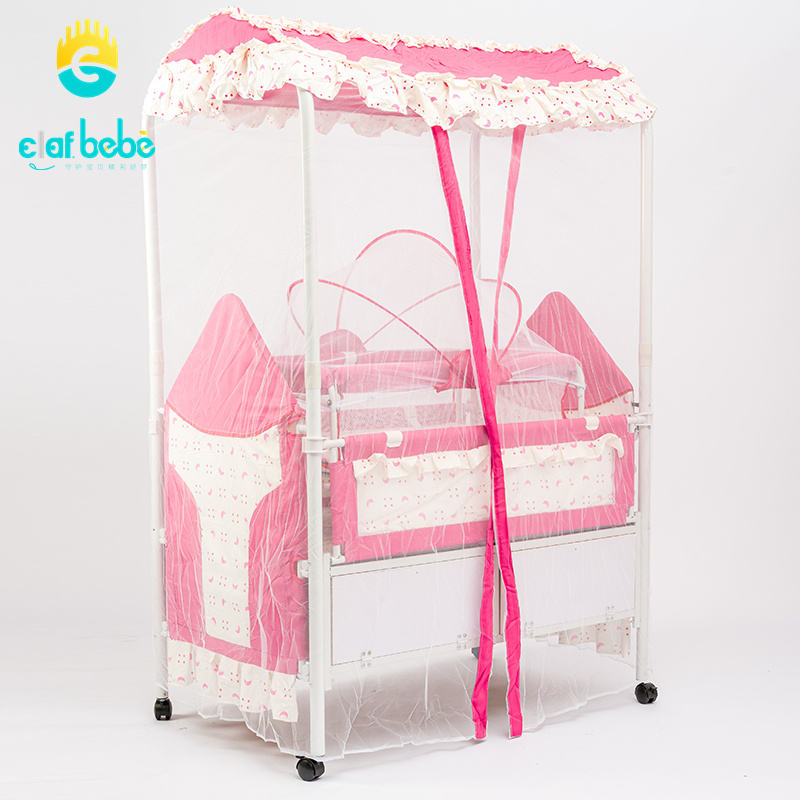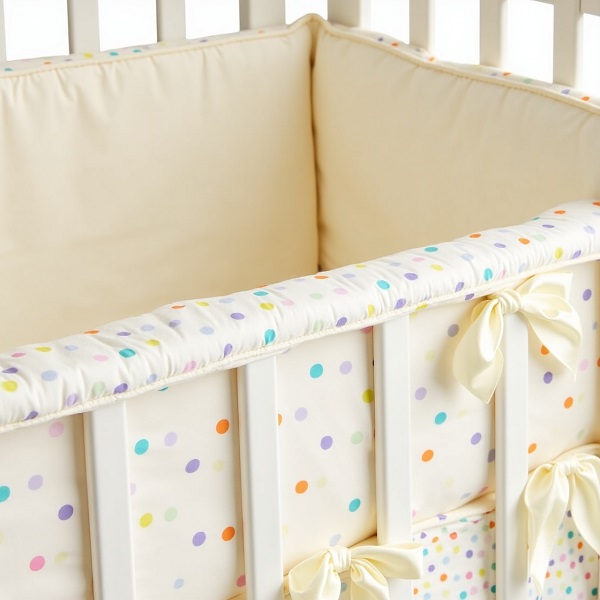If your baby is using a bassinet from the time they are born, it is important to know when it’s time to transition them out of the bassinet in order to accommodate their growth. This guide will help you identify the signs that your baby is ready to move out of the bassinet and provide practical tips for a seamless transition.
Understanding the Purpose of a Bassinet
A bassinet is a small, portable sleeping space designed for newborns and infants, providing a cozy, confined space that helps them feel secure. Bassinets are often placed next to the parent’s bed, making it easy for parents to tend to their baby during the night without getting out of bed. This proximity can facilitate nighttime feedings and quick responses to the baby’s needs.
Bassinets are smaller than cribs, making them ideal for homes with limited space. They fit comfortably in the parents’ bedroom, enabling room-sharing without taking up too much space.
Understanding the Developmental Milestones of a Baby
Babies undergo rapid physical and cognitive development in their first year of life. As they grow, their needs and sleep patterns change, which can signal the need to transition from a bassinet to a crib.
Most cradles have specific weight and height limits, typically around 15-20 pounds. If the baby exceeds these limits, it is time to move to a crib.
As babies grow, their sleep patterns evolve, with longer stretches of sleep at night. A larger sleeping space like a crib can be more comfortable for extended sleep periods.
How Long Can Babies Sleep in a Bassinet?
Experts generally recommend transitioning babies from their cradles or bassinets to a crib at an appropriate age to ensure safety and comfort as they grow. Most experts recommend moving a baby out of a cradle or bassinet and into a crib between four to six months of age. However, some babies may need to transition earlier or later depending on their growth and development.
A baby bassinet serves as an excellent sleeping space for infants. However, due to its limitations, it can only accommodate the baby for a limited time. Therefore, once your child reaches a few months of age, it is necessary for parents to find alternative sleeping arrangements for their baby.
Signs Your Baby Has Outgrown the Bassinet
Here are detailed signs indicating that it’s time to transition your baby to a crib:
1. Your Baby Has Trouble Falling Asleep in the Bassinet
If your baby struggles to settle down and fall asleep in the bassinet, it might be due to a lack of space. As babies grow, they need more room to stretch and find a comfortable sleeping position. The confined space of a bassinet can start to feel restrictive. Babies may express discomfort through difficulty falling asleep, indicating a need for a larger sleeping area where they can move more freely.
2. Your Baby Wakes Frequently During the Night
Babies who previously slept well but begin to wake frequently might be experiencing discomfort due to outgrowing the bassinet. Limited space can lead to disrupted sleep patterns. Transitioning to a crib can provide a more comfortable and spacious sleeping environment, which can help improve the baby’s sleep quality and reduce nighttime awakenings.
3. Your Baby Seems Uncomfortable or Restless in the Bassinet
If your baby appears restless or frequently shifts positions in the bassinet, they may be feeling cramped. This restlessness can manifest as frequent movements, squirming, or hitting the sides of the bassinet. Babies unable to find a comfortable position may exhibit signs of discomfort such as crying, fussing, or difficulty staying asleep.
4. Your Baby Reaches the Height and Weight Limits of the Bassinet
Each bassinet comes with specific weight and height limits. Most bassinets are designed for babies up to 15-20 pounds and a certain length. Exceeding these limits can make the bassinet unsafe. Rapid physical growth during the first few months can quickly make a bassinet too small.
5. Your Baby Starts to Roll Over
Rolling over is a significant developmental milestone that typically occurs around four to six months. Babies who can roll over need more space to safely practice their new skills. In a bassinet, rolling over can increase the risk of suffocation if the baby gets trapped against the sides.
6. Your Baby Starts to Reach or Climb
As babies develop motor skills, they begin to reach, grab, and eventually attempt to climb. These behaviors are unsafe in the confined space of a bassinet. The sides of a bassinet are typically lower than those of a crib, making it easier for an active baby to climb or fall out. Transitioning to a crib with higher sides helps prevent accidents and ensures the baby’s safety.

How Do I Transition My Baby to a Crib?
Prepare Emotionally First
Start by placing the crib in your bedroom if possible, allowing the baby to get used to it while still being close to you. This helps ease the transition by maintaining a sense of security.
Use familiar items like a favorite blanket or a stuffed toy (once they are old enough for such items) to provide comfort and a sense of familiarity in the new sleeping space.
Choose a Comfortable and Safe Crib
Ensure the crib meets current safety standards. Look for features like a sturdy frame, non-toxic materials, and properly spaced slats (no more than 2 3/8 inches apart).
Select a crib with an adjustable mattress height. Start with the mattress at the highest level for newborns and lower it as your baby grows and starts to sit, stand, or climb.
Set up a Sleep-Friendly Nursery
Choose soft, neutral colors for the walls and decor. Pastels and muted tones are calming and can help create a peaceful environment. Install dimmable lights or use a nightlight to create a gentle ambiance during nighttime feedings and diaper changes. Blackout curtains can help block out daylight during nap times.
Keep the nursery at a comfortable temperature, ideally between 68-72°F (20-22°C). Use a room thermometer to monitor and adjust as necessary. Ensure proper ventilation but avoid placing the crib directly under an air vent or near a drafty window.
Maintaining a Safe Sleep Environment
Keep the crib free of pillows, blankets, bumper pads, and stuffed animals. Use a fitted sheet designed for the crib mattress. Always place your baby on their back to sleep. This position is recommended by pediatricians to reduce the risk of SIDS. Use a wearable blanket or sleep sack to keep your baby warm without the need for loose blankets.
Monitoring Baby’s Sleep
Use a baby monitor to keep an eye on your baby’s sleep patterns and to respond quickly if they wake up or need attention. Periodically check on your baby during the night to ensure they are sleeping safely and comfortably.
Keeping a sleep diary can help you identify patterns and understand your baby’s sleep needs. Record when your baby sleeps, for how long, and any disturbances.
Balancing Parental Needs
Place the crib in a convenient location where you can easily reach it for nighttime feedings and soothing. Ensure you are also getting enough rest. An overtired parent is less effective in caring for a baby. Consider sleeping arrangements that allow you to rest while still being responsive to your baby’s needs.
Using Sleep Aids
Consider using a white noise machine to help soothe your baby and mask household noises that might disrupt sleep. If your baby uses a pacifier, it can provide comfort and help with the transition.
Common Mistakes to Avoid to Move the Baby out of the Bassinet
Rushing the Transition
Mistake: Moving the baby to a crib too quickly without adequate preparation.
You should Introduce the crib slowly. Start with placing the baby in the crib for short periods during the day to allow them to get used to the new environment. Once your baby is comfortable, gradually move them to sleep in the crib at night. This approach reduces anxiety and helps them adjust better.
Delaying the Transition
Mistake: Waiting too long to move the baby to a crib, can lead to safety risks and sleep disturbances.
Transition your baby as soon as they show signs of outgrowing the bassinet, such as rolling over, sitting up, or becoming more active. Regularly check your baby’s weight and height to ensure they are within the bassinet’s safety limits.
Failing to Maintain a Consistent Routine
Mistake: Disrupting the baby’s sleep routine during the transition, causing confusion and sleep disturbances.
Keep the bedtime routine consistent. This includes activities like bathing, feeding, reading, and singing lullabies. A predictable routine provides comfort and signals to your baby that it’s time to sleep. Try to replicate the bassinet environment in the crib as much as possible, such as using the same type of sheets or sleep sacks.
Ignoring Your Baby’s Cues
Mistake: Overlooking signs that your baby is ready or not ready for the transition, leading to increased stress for both baby and parents.
Pay attention to your baby’s sleep patterns, comfort levels, and signs of readiness. Indicators include the ability to roll over, sit up, or show discomfort in the bassinet. Be flexible and responsive to your baby’s needs. If they seem particularly anxious or unsettled, consider slowing down the transition process.
Neglecting Your Own Needs
Mistake: Focusing solely on the baby’s transition and overlooking the importance of parental rest and well-being.
Ensure you are also getting enough rest. An overtired parent is less effective in managing the transition. Arrange your sleep setup to make nighttime care easier and ensure you get adequate sleep. Don’t hesitate to ask for help from your partner, family members, or friends during this transition period. Sharing responsibilities can alleviate stress and provide much-needed support.
Conclusion
Moving your baby out of the bassinet is a significant step that requires careful consideration and planning. By recognizing the signs of readiness, ensuring a safe sleep environment, and providing a supportive transition, you can help your baby adjust smoothly to their new crib, promoting healthy sleep habits and overall well-being.
Recommended Related Articles:
- Best Bassinet of 2025: Picks for Wholesale Retailers
- Crib Vs Bassinet: How to Choose for Your Baby?
- 10 Top-Rated Bassinet Manufacturers
- Baby Bassinet Ultimate Guide
- Best Bedside Bassinet: A Complete Guide
- Co-Sleeper Bassinet Guide: Attached to Parent’s Bed
- How to Get a Newborn to Sleep in the Bassinet?













